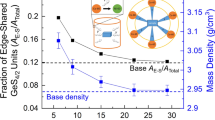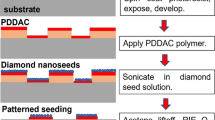Abstract
Previous studies in our laboratory have reported that the chemical etch rate of a commercial photosensitive glass ceramic (FoturanTM, Schott Corp., Germany) in dilute hydrofluoric acid is strongly dependent on the incident laser irradiance during patterning at λ=266 nm and λ=355 nm. To help elucidate the underlying chemical and physical processes associated with the laser-induced variations in the chemical etch rate, several complimentary techniques were employed at various stages of the UV laser exposure and thermal treatment. X-ray diffraction (XRD) was used to identify the crystalline phases that are formed in Foturan following laser irradiation and annealing, and monitor the crystalline content as a function of laser irradiance at λ=266 nm and λ=355 nm. The XRD results indicate the nucleation of lithium metasilicate (Li2SiO3) crystals as the exclusive phase following laser irradiation and thermal treatment at temperatures not exceeding 605 °C. The XRD studies also show that the Li2SiO3 density increases with increasing laser irradiance and saturates at high laser irradiance. For our thermal treatment protocol, the average Li2SiO3 crystal diameters are 117.0±10.0 nm and 91.2±5.8 nm for λ=266 nm and λ=355 nm, respectively. Transmission electron microscopy (TEM) was utilized to examine the microscopic structural features of the lithium metasilicate crystals. The TEM results reveal that the growth of lithium metasilicate crystals proceeds dendritically, and produces Li2SiO3 crystals that are ∼700–1000 nm in length for saturation exposures. Optical transmission spectroscopy (OTS) was used to study the growth of metallic silver clusters that act as nucleation sites for the Li2SiO3 crystalline phase. The OTS results show that the (Ag0)x cluster concentration has a dependence on incident laser irradiance that is similar to the etch rate ratios and Li2SiO3 concentration. A comparison between the XRD and optical transmission results and our prior etch rate results show that the etch rate contrast and absolute etch rates are dictated by the Li2SiO3 concentration, which is in turn governed by the (Ag0)x cluster concentration. These results characterize the relationship between the laser exposure and chemical etch rate for Foturan, and permit a more detailed understanding of the photophysical processes that occur in the general class of photostructurable glass ceramic materials. Consequently, these results may also influence the laser processing of other photoactive materials.
Similar content being viewed by others
References
J. Brannon, J. Greer, H. Helvajian, Laser Processing for Microengineering Applications. In: Microengineering Aerospace Systems, ed. by H. Helvajian (The Aerospace Press, El Segundo, CA, 1999)
A. Huang, W.W. Hansen, S.W. Janson, H. Helvajian, Proc. SPIE 4559, 164 (2001)
A. Huang, W.W. Hansen, S.W. Janson, H. Helvajian, Proc. SPIE 4637, 297 (2002)
H. Becker, M. Arundell, A. Harnisch, D. Hulsenberg, Sens. Actuators B 86, 271 (2002)
W. Holand, G.H. Beall, Glass-Ceramic Technology (The American Ceramic Society, Westerville, OH, 2002)
M. Toner, H. Buettner, Biotechnol. Prog. 14, 355 (1998)
S.D. Stookey, Indust. Engin. Chem. 41, 856 (1949)
S.D. Stookey, Indust. Engin. Chem. 45, 115 (1953)
F.E. Livingston, H. Helvajian, Photophysical Processes that Lead to Ablation-Free Microfabrication, in: Glass-Ceramic Materials, in: 3D Laser Microfabrication, ed. by H. Misawa, S. Juodkazis (Wiley-VCH, Weinheim, 2006) and references therein
P.J. Brock, M.D. Levenson, J.M. Zavislan, J.R. Lyerla, J. Vac. Sci. Technol. B 9, 3155 (1991)
T.R. Dietrich, W. Ehrfeld, M. Lacher, M. Kramer, B. Speit, Microelectron. Eng. 30, 497 (1996)
Y. Cheng, K. Sugioka, M. Masuda, K. Shihoyama, K. Toyoda, K. Midorikawa, Proc. SPIE 5063, 103 (2003)
W.W. Hansen, S.W. Janson, H. Helvajian, Proc. SPIE 2991, 104 (1997)
J. Kim, H. Berberoglu, X. Xu, J. Microlith. Microfab. Microsyst. 3, 478 (2004)
F.E. Livingston, H. Helvajian, Proc. SPIE 4830, 189 (2003)
F.E. Livingston, H. Helvajian, Appl. Phys. A 81, 1569 (2005)
F.E. Livingston, H. Helvajian, NATO Advance Science Institutes – Photon Based Nanoscience and Nanobiotechnology 239, 225 (2006)
M. Masuda, K. Sugioka, Y. Cheng, T. Hongo, K. Shihoyama, H. Takai, I. Miyamoto, K. Midorikawa, Appl. Phys. A 78, 1029 (2004)
K. Sugioka, M. Masuda, T. Hongo, Y. Cheng, K. Shihoyama, K. Midorikawa, Appl. Phys. A 79, 815 (2004)
V. Arbuzov, J. Non-Cryst. Solids 253, 37 (1999)
J.S. Stroud, J. Chem. Phys. 35, 844 (1961)
J.S. Stroud, J. Chem. Phys. 37, 836 (1962)
M. Talkenberg, E.W. Kreutz, A. Horn, M. Jacquorie, R. Poprawe, Proc. SPIE 4637, 258 (2002)
A. Berezhnoi, Glass-Ceramics and Photo-Sitalls (Plenum Press, New York, 1970)
F.E. Livingston, W.W. Hansen, A. Huang, H. Helvajian, Proc. SPIE 4637, 404 (2002)
M.H. Read, Thin Solid Films 10, 123 (1972)
K. Tao, C.A. Hewett, Rev. Sci. Instrum. 58, 212 (1987)
F.E. Livingston, P.M. Adams, H. Helvajian, Proc. SPIE 5662, 44 (2004)
F.E. Livingston, P.M. Adams, H. Helvajian, Appl. Surf. Sci. 247, 526 (2005)
M.F. Barker, T.-H. Wang, P.F. James, Phys. Chem. Glass. 29, 240 (1988)
M.K. Brun, A.S. Bhalla, K.E. Spear, L.E. Cross, R.S. Berger, J. Cryst. Growth 478, 335 (1979)
L.L. Burgner, M.C. Weinberg, P. Lucas, P.C. Soares Jr., E.D. Zanotto, J. Non-Cryst. Solids 255, 264 (1999)
J. Deubener, R. Bruckner, M. Sternitzke, J. Non-Cryst. Solids 163, 1 (1993)
C.J.R. Gonzalez-Oliver, P.S. Johnson, P.F. James, J. Mater. Sci. 14, 1159 (1979)
J.R. Jacquin, M. Tomozawa, J. Non-Cryst. Solids 190, 233 (1995)
A.M. Kalinina, V.M. Fokin, G.A. Sycheva, V.N. Filipovich, in Proc. 14th Int. Congr. on Glass, Vol. 1 (Central Glass and Ceramic Research Institute, Calcutta, 1986)
P.C. Soares Jr., P.A.P. Nascente, E.D. Zanotto, Phys. Chem. Glass. 43, 143 (2002)
P.C. Soares Jr., E.D. Zanotto, V.M. Fokin, H. Jain, J. Non-Cryst. Solids 331, 217 (2003)
G.A. Sycheva, Phys. Chem. Glass. 25, 501 (1999)
U. Kreibig, Appl. Phys. 10, 255 (1976)
F.E. Livingston, H. Helvajian, unpublished results
Author information
Authors and Affiliations
Corresponding author
Additional information
PACS
42.62.-b; 61.43.Fs; 81.05.Kf; 81.10.-h; 83.80.Ab
Rights and permissions
About this article
Cite this article
Livingston, F., Adams, P. & Helvajian, H. Examination of the laser-induced variations in the chemical etch rate of a photosensitive glass ceramic. Appl. Phys. A 89, 97–107 (2007). https://doi.org/10.1007/s00339-007-4197-0
Received:
Accepted:
Published:
Issue Date:
DOI: https://doi.org/10.1007/s00339-007-4197-0




